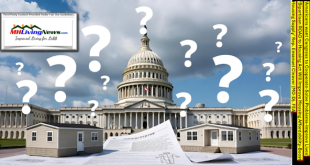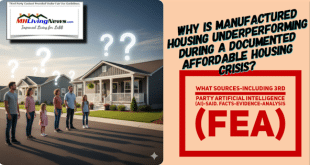Mark Weiss, J.D., President and Chief Executive Officer (CEO) of the Manufactured Housing Association for Regulatory Reform (MHARR), provided the following op-ed to MHLivingNews.
MHARR – ISSUES AND PERSPECTIVES
JUNE 2022
“THE ‘WOKE’ WAR ON AFFORDABLE HOUSING”
The leaders of the “woke” mob – inside government and out — will never admit that they actually oppose affordable housing and homeownership for millions of lower and moderate-income Americans, including inherently affordable manufactured housing. But they do, with every means available to them. Naturally, they deny the truth of what they do to undermine affordable homeownership for lower-income Americans. In fact, they will tell you just the opposite – that they really care about lower-income people and that, through their various efforts, they simply want what (supposedly) is best for them. The comments filed by various “consumer” and “housing” organizations in the recent U.S. Department of Energy (DOE) rulemaking concerning manufactured housing “energy conservation” standards – and the standards themselves — are a good example. But it’s all a lie — a phony, fake narrative. The truth is that the “woke” elite hates affordable homeownership, at least for the lower and moderate-income Americans they use as political pawns.
The “woke” mob’s views regarding homeownership for lower and moderate-income Americans parallel its views on transportation. In the transportation arena, the “woke” crowd, to “save” the planet, ideally wants everyday Americans using government-provided “public” transit. Alternatively, if an American must have a private vehicle, they want it to be an outrageously costly “electric” vehicle. And just to prove the point, they have – and will continue — to do everything in their power to increase the cost of gasoline, to make the excessive cost of electric vehicles seem reasonable by comparison. But not to worry, they’ll help underwrite the ridiculous cost of that electric-powered fire hazard by tossing you a few nuggets in the form of subsidies or tax breaks that can be withdrawn any time the elites want.
So, how does this translate to the affordable housing arena, and how does the woke “elite” in government and beyond undermine the availability of affordable, private-sector homeownership? The first and most comprehensive tool that the “woke” elite deploy against affordable homeownership, and the Americans who need and require affordable homeownership, is restrictive and exclusionary zoning. You see, the woke elitists may claim to support lower and moderate-income Americans, but they do not want to actually live with them. They do not want less costly homes in their neighborhoods. They do not want lower income people living in their neighborhoods. They do not want their children going to school with “working class” kids, and they do not want to rub shoulders with the less affluent at the local wine shop. So, they make sure that affordable housing, like manufactured homes, are excluded from their neighborhoods through discriminatory and exclusionary zoning mandates. And, just like that, the “problem” is solved. They are free to preen and posture about affordable housing, without actually having to live in a community that offers affordable housing opportunities for everyone.
And what exactly does restrictive and exclusionary zoning do to the availability of affordable housing and homeownership? Years of research leaves no doubt whatsoever. Multiple studies have shown that restrictive and exclusionary zoning eliminates affordable housing and increases average home prices substantially. A 2016 Century Foundation study, titled “Understanding Exclusionary Zoning and its Impact on Concentrated Poverty,” states, in relevant part: “Exclusionary zoning … keeps affordable housing out of neighborhoods through land use and building code requirements. It’s a legal practice that has been used for decades to keep lower-income people — disproportionately racial minorities — out of wealthy and middle-class neighborhoods across the country. It can have a damaging effect in that it prevents these low-income families from having access to the education and employment opportunities typically found in wealthier neighborhoods.”
Consequently, it should surprise absolutely no one that discriminatory zoning mandates are routinely deployed to exclude lower cost manufactured housing and the lower and moderate-income Americans who rely on manufactured homes as a source of affordable homeownership. The excuses and rationalizations offered in support of such edicts are legion, but their exclusionary and discriminatory impacts are beyond debate.
How else does the “woke” elite undermine and destroy housing affordability? By increasing the cost of everything, including housing, via rampant inflation fueled, in substantial part, by excessive and unnecessary government spending. In May 2022, the Consumer Price Index (CPI) – the federal government’s measure of inflation within the economy — was 8.6% year-over-year, its highest level since 1981. This has both direct and indirect impacts on the housing market and housing affordability.
Inflation has a direct negative impact on homeownership by increasing the cost of housing itself, and also by fueling higher interest rates for home loans. Given the price sensitivity of lower and moderate-income homebuyers, moreover, this phenomenon disproportionately impacts consumers who would ordinarily seek access to the affordable housing market and manufactured housing in particular. Such direct impacts have been documented in research conducted by the National Association of Realtors (NAR). According to a recent press report: “The median price of a [site-built] home rose to $375,300, the highest ever recorded …. Compared with the prior month, the median price was up 4.5 percent. From a year ago, the median price is up 15 percent. Prices were up in all four major regions of the country. ‘The housing market is starting to feel the impact of sharply rising mortgage rates and higher inflation taking a hit on purchasing power,’ said Lawrence Yun, NAR’s chief economist.”
And while mainstream HUD Code manufactured housing still costs significantly less than a typical site-built home, neither manufactured homes per se, nor manufactured home consumer loans (particularly in the absence of any Duty to Serve support for manufactured home chattel loans) are immune from inflationary pressures within the broader economy. Consequently, with consumer-level inflation exceeding average wage growth in the United States, the cost of housing is rising faster than the ability of Americans to pay for and afford that housing. And, as is always the case, the greatest harm done by inflation is inflicted on those at the lower end of the economic ladder, who have less earning potential and can least afford disproportionate inflation-driven price increases.
Similarly, inflation has an indirect negative impact on access to homeownership. Quite simply, by increasing the cost of virtually all goods and services within the national economy at a faster and steeper rate than the growth of personal income, families are forced to pay more – and a greater proportion of their income – for non-housing related necessities. This inevitably leaves less income available for homeownership. At upper income levels, this cost “squeeze” may require homebuyers to limit purchases to smaller and less costly homes than they otherwise would consider. At lower income levels, however, inflation and skyrocketing costs for everyday living are more likely to drive consumers completely out of the homeownership market for extended periods of time, thus exacerbating homelessness and government dependence. This is reflected by a recent survey of American households conducted by the Federal Reserve Bank of New York. That survey showed that for the first time in at least a decade, fewer than half of current renters expect to eventually own a home — a clear reflection of how deeply the rise in prices has damaged the perceived affordability of homes. But don’t look for changes at the federal level to limit either the excessive spending or other policies that have spiked inflation since 2021. In fact, just the opposite is likely, particularly in advance of the November 2022 mid-term election and the 2024 presidential election.
Then there is the third “leg” of the “woke” trifecta – excessive and discriminatory manufactured housing “energy” regulation. While just a handful of states have adopted the 2018 version of the International Energy Conservation Code (IECC) – with most holding onto versions that are much older, and, therefore, more lenient and less costly – DOE plans to discriminatorily saddle the manufactured housing sector with energy standards based on the most recent 2021 iteration of the IECC. By DOE’s own calculations, this will increase the retail-level cost of manufactured homes by as much as $6,000.00, while excluding millions of lower and moderate-income Americans from the HUD Code market and from housing altogether. And this does not even begin to address added costs due to regulatory compliance costs, which have never even been estimated, because DOE has yet to propose a specific enforcement mechanism. Meanwhile, based on industry estimates, which include the effects of inflation on materials and supplies, the actual cost impact of the looming DOE standards could be well over $10,000.00 per home – which would decimate the manufactured housing market and the availability of inherently affordable homeownership for lower and moderate-income Americans.
But that didn’t bother the “woke” crowd, as dozens of “climate change” and supposed “affordable housing” organizations lined up during the rulemaking process to not only support high-cost DOE energy regulation, but to urge DOE to impose ultra-costly “untiered” energy standards to all manufactured housing across-the-board. Supposedly, these organizations did not want lower-income homebuyers to “suffer” from more lenient energy standards than would be applied to higher-price manufactured homes (never mind the much more lenient standards applied to much higher-cost site-built homes). They never bothered to explain, though, that far from “suffering” from lower energy standards, lower-income buyers would instead suffer from being totally excluded from the manufactured housing market and being unable to buy a home of their own as a result of the draconian cost of the untiered DOE energy standards. Far from “protecting” consumers, then, these organizations were actually lobbying to have Americans at the lower end of the economic ladder – people who currently could qualify to purchase a manufactured home – excluded from homeownership altogether and, therefore, more dependent on “big government” than ever.
Then there is DOE itself and its utter hypocrisy. In a June 9, 2022 propaganda news release touting its final manufactured housing energy standards, DOE totally ignores the massive purchase price increases those standards will cause, and the millions of lower-income Americans who will be denied all of the benefits of homeownership as a result. Instead, DOE brags about the “up to” $475 per year in utility bill savings that allegedly will flow from the new standards. Just one minor problem, though. For those excluded from homeownership by the cost of the new standards, there will be no savings, at all, per se. But even for those not totally excluded from homeownership, Moody’s Analytics reported days ago that Americans are paying an extra $460 every month just for life’s basic necessities, because of inflation now running at 8.6% per month. So, even for those not totally excluded by the new DOE standards, their paltry alleged “benefits” will be dwarfed by over $5,500 in added annual household inflation costs, courtesy of the same administration pushing the baseless and unnecessary DOE standards.
And, while we’re on the subject, let’s not forget the role of the ostensible national representative of “all segments” of the manufactured housing industry in this debacle. For years, and particularly during the sham DOE “negotiated rulemaking” process, the Manufactured Housing Institute (MHI) was all too happy to collaborate with energy special interests and DOE itself, in order to advance IECC-based, DOE federal energy standards. Indeed, MHI and virtually all of its members on the DOE Manufactured Housing Working Group (MHWG) (with one single abstention) voted in favor of the October 2014 negotiated rulemaking “Term Sheet” that was the precursor to the “final” DOE energy standards. MHARR, for its part, cast the one and only MHWG “no” vote on that Term Sheet. All of which begs the question, why would any national representative of an industry that thrives on – and is based on – purchase price affordability (as memorialized under federal law), go along with such a process and such a result? MHARR is studying all of this within a broader context and will soon publish the noteworthy results for the industry, consumers and energy stakeholders.
Far from promoting “equity,” then – or anything of the kind – both the DOE “final” energy standards and the “woke” organizations’ effort to impose the harshest standards across-the-board, were and are nothing more than a cynical, contemptuous attempt to balance a “climate change” agenda on the backs of hard-working yet lower-income families who will be excluded from homeownership as a result.
So, “wokesters,” spare us the claptrap. The truth is that your “equity” is as phony as a three-dollar bill. Far from helping the working poor and countless other lower and moderate-income Americans, you are their worst enemy, working to deprive them of life’s most essential elements, beginning with a safe, decent and affordable home. ##
Mark Weiss
MHARR is a Washington, D.C.-based national trade association representing the views and interests of independent producers of federally-regulated manufactured housing. ###
“The Devil is in the Details” – Additional Information, MHLivingNews Analysis and Commentary
There is an old saying that “the devil is in the details.” The MacMillan Dictionary explains that saying is “used for saying that something may seem simple, but in fact the details are complicated and likely to cause problems.”
Left-leaning Wikipedia said something similar about that same maxim that: “The devil is in the details” is an idiom alluding to a catch or mysterious element hidden in the details; it indicates that “something may seem simple, but in fact the details are complicated and likely to cause problems…”
It is the details and their meaning that will be examined in this analysis.
The evidence-based analysis that follows has implications for and impacts on affordable housing seekers, current and potential manufactured home consumers, as well as manufactured housing professionals.

MHARR’s President and CEO – Mark Weiss, J.D. – has made several significant statements and claims in the above that merit examination. The bullets below are quotations from the above.
- The leaders of the “woke” mob – inside government and out — will never admit that they actually oppose affordable housing and homeownership for millions of lower and moderate-income Americans, including inherently affordable manufactured housing. But they do, with every means available to them. Naturally, they deny the truth of what they do to undermine affordable homeownership for lower-income Americans. In fact, they will tell you just the opposite – that they really care about lower-income people and that, through their various efforts, they simply want what (supposedly) is best for them.
- The comments filed by various “consumer” and “housing” organizations in the recent U.S. Department of Energy (DOE) rulemaking concerning manufactured housing “energy conservation” standards – and the standards themselves — are a good example. \
- But it’s all a lie – a phony, fake narrative. The truth is that the “woke” elite hates affordable homeownership, at least for the lower and moderate-income Americans they use as political pawns.
MHARR’s CEO has also ripped the Manufactured Housing Institute (MHI) for their part in this alleged pattern.
- And, while we’re on the subject, let’s not forget the role of the ostensible national representative of “all segments” of the manufactured housing industry in this debacle.
- For years, and particularly during the sham DOE “negotiated rulemaking” process, the Manufactured Housing Institute (MHI) was all too happy to collaborate with energy special interests and DOE itself, in order to advance IECC-based, DOE federal energy standards.
- Indeed, MHI and virtually all of its members on the DOE Manufactured Housing Working Group (MHWG) (with one single abstention) voted in favor of the October 2014 negotiated rulemaking “Term Sheet” that was the precursor to the “final” DOE energy standards.
- MHARR, for its part, cast the one and only MHWG “no” vote on that Term Sheet.
- All of which begs the question, why would any national representative of an industry that thrives on – and is based on – purchase price affordability (as memorialized under federal law), go along with such a process and such a result?
It should be recalled that a staffer for a Democratic lawmaker has told MHProNews that MHI has a reputation on Capitol Hill as being ‘anti-consumer.’ Hold that thought.
Then, consider the notion advanced by MHARR’s Weiss. Is MHI also against the interests of smaller, independent firms?
- Does MHI tilt in favor of larger producers of manufactured homes?
- Note that those top three largest producers of HUD Code manufactured housing are each to various degrees vertically integrated, meaning, they own not only production but also have retail outlets that are company owned and/or corporately affiliated.
- Turning to land-lease communities, are the larger firms at MHI favored over the independently owned smaller companies, notably those that are family owned businesses?
Let’s note that there are several topics that could reasonably considered as highly polarizing in America. Among them are, in no certain order of importance, the following.
- Gun control/2nd
- Abortion/Pro-Life Issues.
- Climate change and the call for green energy.
- Affordable housing, NIMBYism, which includes or impacts manufactured homes.
Let’s set the first two topics aside for the purposes of this analysis. Let’s begin by considering the fourth item above, and then circling back later to #3.
No less a source than the U.S. Department of Housing and Urban Development (HUD) has said in a HUD PD&R (Policy Development and Research) article that for 5 decades, Democrats and Republicans have known the causes and possible cure for the affordable housing crisis in America. In a report dated 9.7.2021 on the HUD website: “In this article, Pam Blumenthal and Regina Gray discuss the impact of regulatory barriers on housing affordability.” Certainly, energy is a regulatory issue too, but let’s set that aside for later, and focus – as did Blumenthal and Gray – on regulatory barriers at the state and local levels.
In a reference to the law of supply and demand, Blumenthal and Gray wrote: “The consequences of inadequate supply are higher housing costs for both renting and buying a home.” They noted that millions of homes, perhaps 3+ million, were needed but not produced after the 2008 housing/finance crisis.
Blumenthal and Gray said:
- “The regulatory environment — federal, state, and local — that contributes to the extensive mismatch between supply and need has worsened over time.”
Then comes the stunning admission noted in this analysis above.
- “Federally sponsored commissions, task forces, and councils under both Democratic and Republican administrations have examined the effects of land use regulations on affordable housing for more than 50 years. Numerous studiesfind land use regulations that limit the number of new units that can be built or impose significant costs on development through fees and long approval processes drive up housing costs.”
It should be obvious that limiting supply through regulation (or any other means) contributes to the problem of too few housing units. A not unrelated outcome of too few units is that state, federal, or local tax dollars assigned to affordable housing related issues are driven up by a lack of supply too. Here is how the HUD PD&R researchers phrased that reality.
- “Research indicates higher housing costs also drive up program costs for federal assistance, reducing the funds available to serve additional households.
So, regardless of political party – per HUD’s researchers – for 5 decades (some 50 years), public officials have talked about this or that ‘solution’ or ‘program’ but the problem has persisted. Put differently, there has been lots of happy talk but no actual solution advanced.
It is worth noting that not long before Blumenthal and Gray’s research article made these observations, MHLivingNews published research that used federal, nonprofit, and other information sources that came to a similar conclusion. Namely, that public officials have known about the causes and possible cures without taking each of the steps necessary to effect the cure. The fact that the problem still exists is all the evidence needed to demonstrate that the proposed or discussed cures didn’t work.
As a quick and relevant aside, HUD’s researchers never used the words “manufactured home” or “manufactured housing” in their article referenced above. That is odd at best, given that HUD is the primary federal regulator of manufactured housing. Hold that thought.
With that 50-year history in mind, Weiss’ stated concerns seem less hyperbolic, doesn’t it? When federal officials, referencing the data, say that public officials know the causes and the cures to the affordable housing crisis but haven’t acted, that’s a troubling problem. When something has happened before, it is apparent that it can happen again.
It isn’t just MHARR that is vexed by the DOE’s new rule. MHI’s own CEO has voiced her concerns too. See that in her own words in the report linked below.
What MHI’s CEO, Lesli Gooch, Ph.D., doesn’t openly admit in the above is the specific allegation that MHARR’s Weiss has made. Namely, that MHI has been – behind the scenes to some extent – part of the problem rather than part of the solution on the DOE energy rule process.
Our MHProNews sister site has provided documents obtained from DOE that make clear that MHI has repeatedly reached out to federal officials to do a ‘negotiated rule making.’
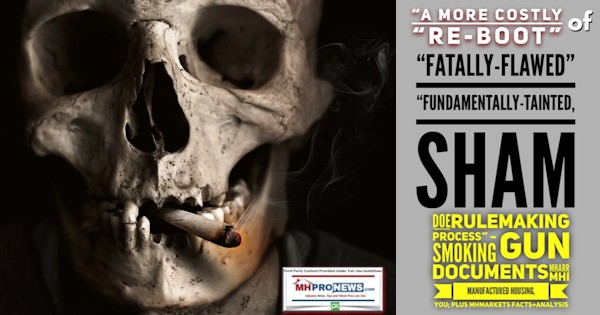
Once MHProNews reported that, MHI perhaps surprisingly revealed and admitted that they have asked DOE for their own rule.
https://www.manufacturedhomepronews.com/masthead/shock-manufactured-housing-institute-boldy-gives-unforced-error-doc-after-favorable-court-ruling-mhi-charged-throwing-lifeline-to-doe-energy-rule-mhi-admits-harms/
Meaning, MHI has effectively said, don’t use your rule DOE, we’ll provide a set of energy standards for you to use. That was all but an admission by MHI of what MHARR, MHProNews, and other critics of MHI have alleged for some years.
Let’s sum up before proceeding.
- MHI and MHARR both agree that manufactured homes are energy saving.
- Indeed, energy standards are an important part of what’s been mandated by HUD Code manufactured housing standards and have been since federal regulations took effect on June 15, 1976.
- So, on this date, and for the past 46 years, manufactured homes – unlike some of their mobile home predecessors – have used energy saving features. MHARR and others provided facts, referenced by Weiss above, that makes clear that manufactured homes have meaningful and effective energy standards.
- Additionally, those who want to save even more on energy can always make the decision to pay extra for energy upgrades as a option. That has long been available, for decades before the DOE entered the picture.
Entirely separate from manufactured housing sources are the research results of third-party professionals such as the Minneapolis Federal Reserve economist James A “Jim” Schmitz Jr. and that of Samuel “Sam” Strommen at Knudson Law.
While each takes a different approach, both raise fact and evidence-based concerns that manufactured housing is steadily being undermined and harmed by corporate monopolists working in concert with federal officials.
What Weiss, Strommen, and Schmitz have said is not so different than what famed author-economist John Kenneth Galbraith said was the pattern with regulatory agencies.
That pattern has been described by some as the Iron Triangle, where elected officials, regulators, and representatives of corporate interests each provide favors to the other in a method that has for years drawn too little understanding as to how it harms the broader public interest.
Typically pro-MHI blogger George Allen recently admitted that many in manufactured housing feel disenfranchised by MHI’s behavior.
https://www.manufacturedhomepronews.com/masthead/manufactured-housing-institute-mhi-lashed-by-current-past-members-odd-defense-of-arlington-va-based-mhi-association-suggested-meeting-for-new-post-production-national-trade-group-considered/
Additionally, several MHI connected members have previously or recently announced efforts to supplant MHI’s leadership of the post-production sector with a new organization that does what MHI claims – but arguably fails – to do. Namely, represent “all segments” of the industry, not just the interests of big brands that dominate the MHI board.
Even MHI’s chairman, manufactured home retailer Leo Poggione, when his firm is examined, it is substantially owned by Cavco Industries (CVCO).

MHI’s prior chairman, Joe Stegmayer, was Cavco’s Chairman and CEO. Stegmayer’s hold on that post at Cavco ended when it was announced that the Securities and Exchange Commission (SEC) opened a probe of he and his company for possible violations of federal laws. Stegmayer stepped down from his post at Cavco after that SEC announcement, but he oddly remained chairman of MHI. Later, when the SEC filed suit against Stegmayer, Cavco and others, Stegmayer entered into an agreement with the SEC that included a hefty fine. See those devilish details in the SEC pleadings, found in the report linked below.
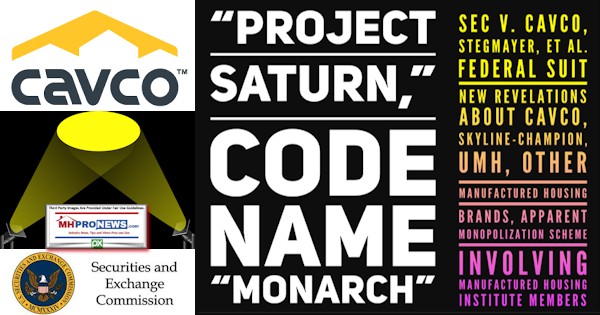
To somewhat simplify what can seem to be a complex set of interlaced issues, there is clear evidence that MHI’s former chairman and the leader of one of their top brands has violated federal laws. That has not yet been adjudicated. That said, the fact that Stegmayer entered into a deal with the SEC certainly suggests to thoughtful and objective thinkers that wrongdoing occurred. There is no known evidence that the former Cavco leader was ever repudiated by MHI. In terms of day-to-day messaging and behaviors, life for Stegmayer at MHI went on as if the SEC legal issues never happened.
Then, consider the seemingly increased tempo of consumer complaints lodged against several of MHI’s top brands, particularly from the community sector. Some examples of that was unpacked in the articles linked below. Keep in mind that MHI has a piece of paper, that is also available digitally, that claims to be their ‘code of ethical conduct.’ What follows, though, should be weighed against the point that some MHI state affiliate sources have said that there is no known examples of MHI actually invoking their code of ethical conduct.
Put differently, there are years of examples that MHI postures and says what may superficially seem to be nice sounding things. But when the curtain is pulled back, and the facts are examined, what emerges from the evidence is something that contradicts MHI’s claims.
- As that Democratic staffer referenced above asserted, MHI has an anti-consumer reputation.
- But MHI also could be asserted that MHI increasingly is questioned for how they are harming the interests of manufactured housing independents.
MHARR has made the argument in recent years that the industry – think including MHI – has to pull together and enter into litigation to stop the ill effects of this looming DOE energy rule. It is now less than a year before those rules, if not stopped, will go into effect.
MHI admits the risk but has proposed a legislative and a regulatory fix. Those are specifically explored in the report linked below.
https://www.manufacturedhomepronews.com/masthead/h-r-7651-manufactured-housing-affordability-and-energy-efficiency-act-of-2022-skopos-labs-govtrack-reveal-duplicity-or-madness-of-manufactured-housing-institute-mhi-advocacy-claims/
What that report reveals is that the legislative fix that MHI claims to have launched has, per Skopos Labs and GovTrack, only a 1 percent chance of being enacted. But as that same report points out, it is highly unlikely that Joe Biden will reverse course on his energy agenda and sign such a bill into law. For the same types of reasons that have driven Secretary Jennifer Granholm lead DOE and the Secretary Marcia Fudge led HUD is unlikely to provide the relief that MHI says they hope to get from the later.
Summing Up
What the devilish details listed and linked above reveal apparently reveal could be summed up like this. MHI has for years been part of the problem on housing affordability. MHI has behaved in a fashion that benefits a few insiders, while often harming smaller manufactured home companies. As the manufactured home industry consolidates, employees are also negatively impacted, per third-party research.
Consumers and ‘white hat’ manufactured home professionals alike ought to be on largely the same page. The reasons for that are found in the reports linked below.

Will MHI pivot, based on such factual and evidence-based revelations and analysis? There are some that hope so. Time will tell.
But what is certain is that years of problems encountered by manufactured housing professionals, as well as untold thousands of manufactured home customers who have suffered as a result of the ‘predatory’ business practices that are connected with certain MHI member brands, several questions arise. Why do some MHI brands – who have company officials who are surely aware of such facts as those outlined and linked herein – stick with MHI? Why do they not openly complain or press for changes?
One troubling but plausible answer is fear. Just as some residents fear retaliation by predatory community operators, so too some smaller firms fear the predatory tactics that specific MHI member firms have and still can deploy.
This is why research by third parties such as Schmitz and Strommen are relevant. A useful document that links and pulls together these and other facts is found on the FHFA website, at the link below.
https://www.fhfa.gov/Media/Documents/Kovach-statement.pdf
As the midterms approach, the above should remind all that merely saying things that sound good at first blush is hardly evidence that the words are sincere or that the follow through will occur. MHI has long postured and focused on photo or video ops without apparently doing the practical steps that could achieve what they claim to rail against.
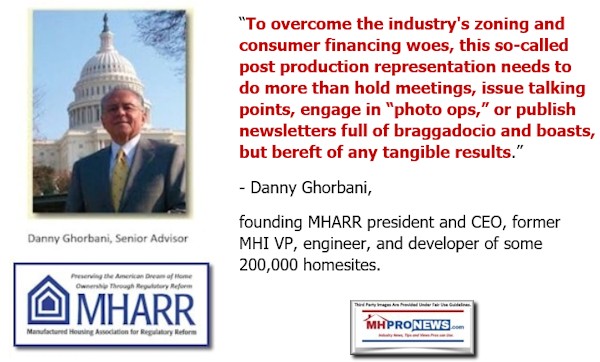

Consider the pull quotes above as evidence for that sobering statement. MHLivingNews will continue to monitor and report, as does MHProNews, on issues that impact consumers, taxpayers, independent businesses and others. ##





That’s a wrap on this installment of “News through the lens of manufactured homes and factory-built housing” © where “We Provide, You Decide.” © ## (Affordable housing, manufactured homes, reports, fact-checks, analysis, and commentary. Third-party images or content are provided under fair use guidelines for media.) (See Related Reports, further below. Text/image boxes often are hot-linked to other reports that can be access by clicking on them.)

By L.A. “Tony” Kovach – for MHLivingNews.com.
Tony earned a journalism scholarship and earned numerous awards in history and in manufactured housing. For example, he earned the prestigious Lottinville Award in history from the University of Oklahoma, where he studied history and business management. He’s a managing member and co-founder of LifeStyle Factory Homes, LLC, the parent company to MHProNews, and MHLivingNews.com. This article reflects the LLC’s and/or the writer’s position, and may or may not reflect the views of sponsors or supporters.
Connect on LinkedIn: http://www.linkedin.com/in/latonykovach
Recent and Related Reports:
The text/image boxes below are linked to other reports, which can be accessed by clicking on them.
 manufacturedhomelivingnews.com Manufactured Home Living News
manufacturedhomelivingnews.com Manufactured Home Living News



